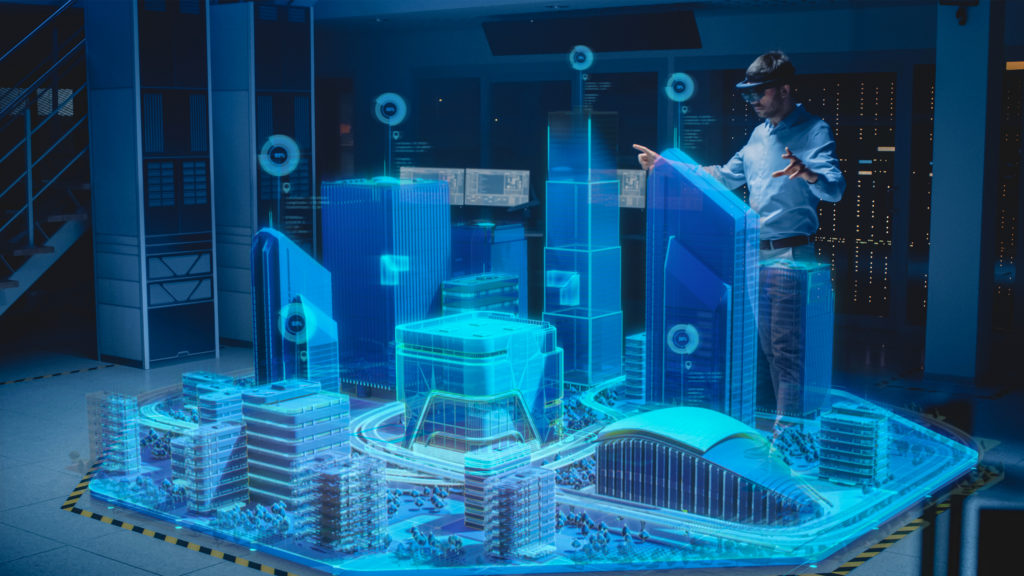Emerging Tech and CRE: IoT in CRE

October 2021 // NAI DESCO Blog
IoT in CRE: The smart development, and smarter CRE professional
It is a well-established fact that digital transformation and the integration of technology have impacted almost every aspect of human life including our workplaces – and commercial real estate (CRE) is no exception.
With this in mind, we’re taking a look at the emerging technologies that are changing property in a new series of blog posts. This is the first, and in it we will look at the current and future possibilities of internet of things (IoT) technology in CRE.
Smart things 101
First off, let’s start with a basic definition of IoT. IoT makes “dumb” things “smart”, or disconnected things into connected ones. It includes a range of sensors and communication modules so that physical things – doors, parking booms, lighting arrays, heating, ventilation, and air conditioning (HVAC) systems, boilers, etc. – can be monitored and controlled remotely.
IoT also supports further digital transformation, such as machine learning in which data can be used to teach a system to the point of a high degree of autonomy.
Green ambitions and controls
IoT has a large number of applications in our CRE developments already, but one of the most common (and commonly understood) is how they can aid in managing energy and systems like lighting and HVAC – from the simplest option of running on a thoughtful schedule to dynamic adjustment in response to factors like the weather and footfall.
SpaceIQ is a company that offers a suite of software solutions for companies that want to improve workplace productivity. They talk about the efficiency these types of systems provide, explaining: “sensors that integrate with your lighting system can track room occupancy and activity. Based on the occupancy data, the sensors can automatically turn lights on and off. Having lights automatically turn on only when rooms or spaces are in use can translate to significant energy savings”.
These types of sensors can be used to adjust cooling and heating too, based on the real-time occupancy of a building. This is not just efficient energy use but can boost the experience of a space, for workers in an office and for shoppers in a retail center.
Digital twins
This is why IoT in facilities management is becoming an exciting area, as well as a means to maximize profit and curtail costs. With well implemented data collection, we are now able to produce “digital twins” to our buildings, or a virtual representation of a building that can show in real time the state of that building and its systems.
Forbes has a recent article on this, quoting John D’Angelo, US real estate leader from Deloitte Consulting. D’Angelo explains that insights gleaned from using IoT data can be used to track “how the building operates to make [..] operations more efficient, improve occupant (shopper, resident and patient) experiences and identify issues or potential issues”.
Wide use potential
Yahoo Finance – quoting from a new market study published by Global Industry Analysts Inc., (GIA) – says that the “IoT Analytics Market” is expected to be worth some $40.6 Billion by 2024. The breakdown of the in-demand IoT functions to watch over the next two years as “demand response, distributed energy generation and storage, smart meters, and fleet management” predicting these “will emerge as largest IoT spending categories”.
“Applications with medium-term potential include automated inventory management, and predictive equipment maintenance,” they add.
Security first
Although the potential for these systems is almost limitless, we must caution that connecting a boiler – for example – to the internet for remote monitoring and maintenance, also means opening that boiler and system up to the possibility of bad actors or “hackers”.
One needn’t look beyond the headlines for multiple examples of how important this factor is – as the recent Colonial Pipeline attack so clearly illustrated.
Any connected system will require security too, ideally from an expert in IoT systems – as the connection protocols for physical objects (whether retrofitted with comms tech or designed to be smart) can be vastly different from those of our phones and computers.